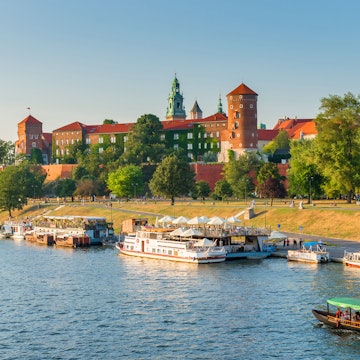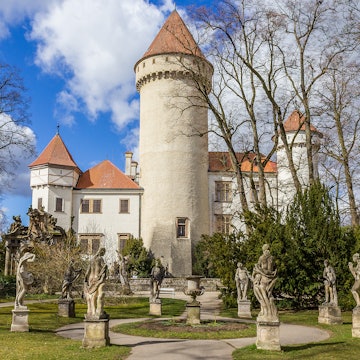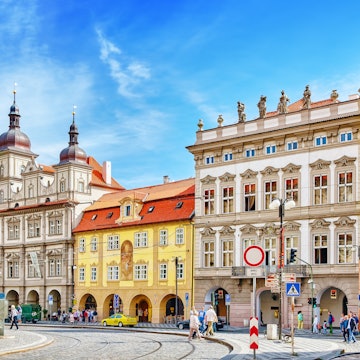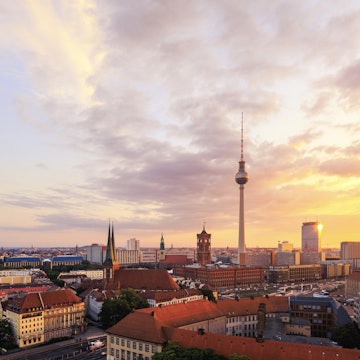

From exploring the city by boat to navigating public transportation, here's how to get around in Prague © Gavin Hellier / Stocksy United
Prague, a city of 1.3 million people, is spread out into 10 sprawling districts that fan clockwise around a historic core.
The good news for visitors, though, is that most of the sights are crammed into a relatively compact area bordering both banks of the Vltava River – and the public transportation system is excellent.
From metros and trams to Uber and bikes, here's everything you need to know about each mode of transport and the all-important ticketing system in Prague.
Cover long distances fast on the metro
The metro, or subway, is cheap, efficient and the quickest way to cover long distances. The metro conveniently serves both the main train station (metro: Hlavní nádraží) and bus station (Florenc) and runs to the connecting point (Nádraží Veleslavín) for catching public buses to and from Prague Airport. The system operates daily from 5am to midnight.
Tips for taking the metro: The A line (green) is handy for moving between major sights. It links central Wenceslas Square (at stations Můstek and Muzeum) to Old Town Square (Staroměstská) and Malá Strana (Malostranská) and brings visitors to within walking distance of Prague Castle (Hradčanská).

Make the most of the extensive tram network
Prague’s impressive tram network stretches out like tentacles to all parts of the city and is useful for traveling both short and long distances. During peak times, tram cars turn up at intervals ranging from 4 to 8 minutes (longer in the evenings). Normal service runs from around 5am to midnight, after which a skeletal fleet of night trams enters into service. The Prague tram map looks daunting at first but learning a few key routes can save time and money.
Tips for taking the tram: Tram 22 follows a highly picturesque route and passes near many top tourist attractions, including Prague Castle and Malá Strana.
Use buses for places off the tourist map
Prague has an extensive network of buses, though most lines serve outlying districts which are of less interest to visitors. There are two exceptions: Bus 119 runs from Prague Airport to the Nádraží Veleslavín metro station. Bus 112 links the Nádraží Holešovice metro station to Prague Zoo.

Explore central Prague on foot
Pack comfortable shoes and prepare to do a lot of walking in Prague. Much of the center, including most of Staré Město (Old Town) and Malá Strana (Little Quarter), is closed to vehicular traffic so traveling by foot is often the only option for getting around.
Rent a bike
Cycling in Prague can be fun and convenient, and city officials are slowly building a network of dedicated cycling routes. That said, Prague’s congested, narrow roads, cobblestones, omnipresent trams and slow-moving groups of pedestrians all pose potential dangers.
Several companies operate day rentals or short-term bike-share schemes, though locals prefer to hire pink Rekola bikes from stands around town. Download the app to get started. Single rides start at 35Kč for 30 minutes.
Catch a ferry for scenic views
The public transit authority operates several commuter ferries that cross the Vltava at regular intervals. Ferries are both convenient and highly scenic. Some run all year, while others only from April to October.
Tips for taking the ferry: A pretty, year-round ferry connects the eastern bank of the river, south of the Old Town at Výtoň (trams 3, 7, 17) to the Císařská louka stop in Smíchov on the western side.

Take the funicular to the top of Petřín Hill
The Petřín funicular railway climbs to the top of Petřín Hill, with scenic views of the city below. The funicular not only spares visitors the long, steep climb, but it’s fun in its own right (especially for kids). Find the lower station near the Újezd tram stop (trams 9, 12, 20, 22) in Malá Strana.
Ask yourself if you really need a car
As a visitor, it’s unlikely you’ll ever need to drive in Prague. The older, central parts of the city are warrens of one-way streets, while the wider roads that radiate outside the center are choked with traffic. To make matters worse, in many districts street parking is limited to residents, and finding a legal parking spot can be time-consuming. The best advice is to stow the vehicle and opt for public transport.
Book taxis and ride-shares ahead of time
Uber, Bolt and locally-owned Liftago are highly popular, relatively cheap ride-share apps. AAA Taxi is a reliable, traditional radio-taxi service. Dishonest drivers remain a problem and it’s better to order a vehicle via an app, over the phone or online than hail one directly on the street.
Accessible transportation in Prague
The Prague Public Transit Authority (DPP) has made great strides in refitting metro stations, trams and buses to make them accessible to all travelers, though the situation remains spotty. Many metro stations now have lifts, but some do not. Likewise, many trams and buses allow for curb-level entry (but not all). See the DPP website for information in English on barrier-free travel.

Transport tickets and passes
The Prague Public Transit Authority (DPP) operates an integrated transport network; the website is the best source for up-to-date travel information, including timetables and fares.
Single-ride tickets of short (30-minute) and long (90-minute) durations are available, as well as passes for one and three days. Children under 15 and seniors over 64 travel free. Tickets and passes are valid for all metros, trams, buses and ferries, and can be used to transfer between services. Those with a valid one- or three-day travel pass can also ride the Petřín funicular, or else tickets can be bought from vending machines at the stops for 60Kč ($2.70).
Validate tickets in yellow stamping boxes before starting the journey. Find these at the top of escalators in metro stations and on tram cars and buses.
Where to buy tickets
Buy tickets and passes at self-service machines in metro stations or in person at many (but not all) newspaper kiosks. Ticket machines take both cash and debit/credit cards. Many trams are equipped with automated ticket machines, which allow for the purchase of tickets and passes with a contactless debit/credit card.
Tip for buying public transport tickets: It's best to buy several tickets in advance or – even better yet – a one- or three-day pass.














